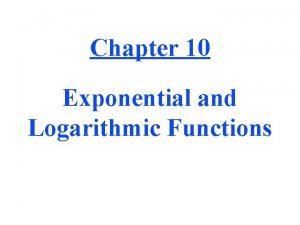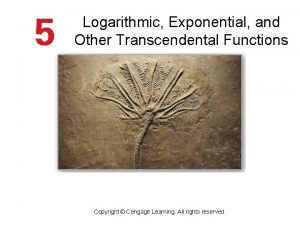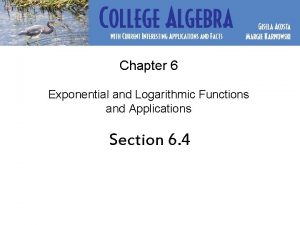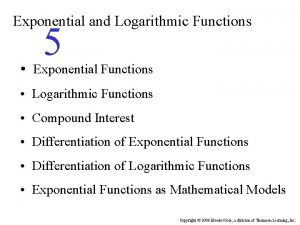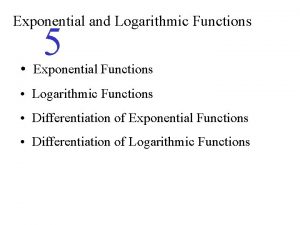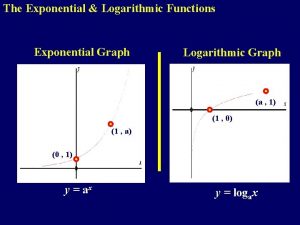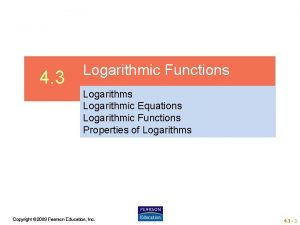4 2 Logarithmic Functions Graphs of Exponential Functions








- Slides: 8

4. 2 Logarithmic Functions

Graphs of Exponential Functions • The graph of f(x) = bx has a characteristic shape. – If b > 1, the graph rises quickly. – If 0 < b < 1, the graph falls quickly. – Unless translated the graph has a y-intercept of 1. – Note the domain and range! 24

Definition of a Logarithm • A logarithm, or log, is defined in terms of an exponent: – If 52=25 then log 525=2 – You can say that the log is the exponent we put on 5 to get 25 • If bx=a, then logba=x

Logarithmic Functions x = 2 y is an exponential equation Its inverse (solving for y) is called a logarithmic equation Here are the parts of each type of equation: Exponential Equation Logarithmic Equation y = loga x x = ay exponent /logarithm base number

Example: Example Solve loga 64 = 2 Rewrite in exponential form! loga 64 = 2 base number exponent 2 a = 64 a=+8→a=8 Example : Solve log 5 x = 3 Rewrite in exponential form: 53 = x x = 125

Graphs of Logarithmic Functions • The graph of f(x)=logbx has a characteristic shape. – The domain of the function is {x | x >0} – Unless translated, the graph has an x-intercept of 1. – Note the domain and range! -1 1 2 3 4 5 6

How do you graph a logarithmic function? Re-write it as an exponential function and make a T-chart: Example: Graph y = log 3 x Rewrite as: x = 3 y = 3 x x y 1/9 1/3 1 3 9 -2 -1 0 1 2 y = log 3 x y

The logarithm with base 10 is called the common logarithm (this is the one your calculator evaluates with the LOG button) The logarithm with base e is called the natural logarithm (this is the one your calculator evaluates with the LN button)
 Quadratic function table examples
Quadratic function table examples Chapter 9 exponential and logarithmic functions answer key
Chapter 9 exponential and logarithmic functions answer key Lesson 10-2 exponential growth and decay
Lesson 10-2 exponential growth and decay Integration of exponent
Integration of exponent Chapter 5 exponential and logarithmic functions
Chapter 5 exponential and logarithmic functions Chapter 6 exponential and logarithmic functions answers
Chapter 6 exponential and logarithmic functions answers Logarithmic exponential and other transcendental functions
Logarithmic exponential and other transcendental functions Chapter 5 exponential and logarithmic functions answer key
Chapter 5 exponential and logarithmic functions answer key Property of equality for exponential functions
Property of equality for exponential functions


